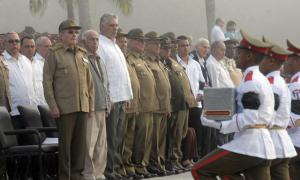
The same land where in life they saw glory and victories, received on January 13 the remains of 104 combatants killed during the War of Liberation or who passed away after the triumph of the Revolution, in the mausoleum to the heroes and martyrs of the Frank País Second Eastern Front, where they were reburied in a military ceremony presided by Army General Raúl Castro Ruz.
Under the dense dawn mist, on the foothills of Loma de Mícara, the urns covered by the Cuban flag were moved from the Second Front Central Museum in 18 military vehicles along the one kilometer route to the mausoleum, lined by royal palms and accompanied by the music composed for this sacred site by Frank Fernández.
The military honors included a rendition by the Revolutionary Armed Forces (FAR) General Staff Marching Band of the lyrical poem “Hasta pronto” that Comandante of the Revolution Juan Almeida Bosque dedicated to the martyrs, and the remains were placed in the center of the polygon-shaped ceremonial site.
“Each one of them,” noted the Second Secretary of the Party Central Committee and combatant of this Front, Comandante José Ramón Machado Ventura, on referring to his comrades in arms, “devoted himself to fulfilling the assigned task, be it as a rank-and-file combatant, or in undertaking high responsibilities commanding a column, unit or forming part of some of the leadership departments.”
Machado, also a vice president of the Councils of State and Ministers, noted that six combatants made the ultimate sacrifice, losing their lives in action or combat, while the other 98 had the privilege of enjoying the revolutionary triumph of January 1, 1959. He added that many reached high ranks within the FAR and the Ministry of the Interior (Minint), or held high responsibilities in the Party, Government or administration.
“The most important thing,” he emphasized regarding those whom he defined as representatives of the wide range of compañeros that initiated and today continue to advance the Revolution, “is that all, without exception, were there where duty called,” adding that their sacrifice was not in vain, as it is enough to see in this municipality or any other of the country, the work that has been built as a monument to their memory.
“Today,” he stressed, “when the economic war and the campaigns of lies and gross slander intensify against Cuba, we ratify, on depositing the remains of 104 brothers in this site of so much symbolism, the commitment to continue being faithful to their example, and spare no efforts or sacrifice in the effort to make our homeland more free, prosperous and sovereign every day.”
The urns carrying the remains, in the hands of members of the FAR General Staff Ceremonies Unit, were moved to the burial mounds and ossuaries moments after the floral wreaths on behalf of Army General Raúl Castro Ruz, the Cuban people and combatants’ relatives were laid before the eternal flame that burns in memory of all combatants at this site.
Once the remains were reburied, in a posthumous tribute, the Marching Band played the National Anthem and a three-volley gun salute was simultaneously fired by an Eastern Army infantry platoon, while the troops composed of students from the Camilo Cienfuegos Military School of Santiago de Cuba, tank-crew members, combatants of the Border Brigade, and special troops stood to attention.
After the ceremony, which was attended by 1,500 guests from the town of Mayarí Arriba, the President of the Councils of State and Ministers, Army General Raúl Castro Ruz, lay a single white rose before the eternal flame and then dedicated another to his unforgettable comrade-in-arms and life companion, Vilma Espín Guillois, at the monument that treasures her ashes.
Other members of the Party Political Bureau, Party and state leaders, high ranking members of the FAR and Minint, directors of the Association of Combatants of the Cuban Revolution, the First Secretary of the Party in the province, Lázaro Expósito Canto, combatants of the Second Front and relatives of the martyrs, placed roses before the eternal flame and at the 377 burial mounds and ossuaries that have been occupied since the inauguration of the mausoleum until today.
Founded by Raúl on March 11, 1958, following orders from Comandante en Jefe Fidel Castro Ruz, the Second Front came to control 12,000 square kilometers of territory in the current provinces of Guantánamo, Holguín and Santiago de Cuba, where more than 250 combative actions made an important contribution to the revolutionary triumph.
In addition, the Front trained numerous combatants and cadres, and revealed the genius of Comandante en Jefe Fidel Castro Ruz in leading the war, and the political and military qualities of its founder, Comandante Raúl Castro Ruz. (Taken from en.granma.cu)